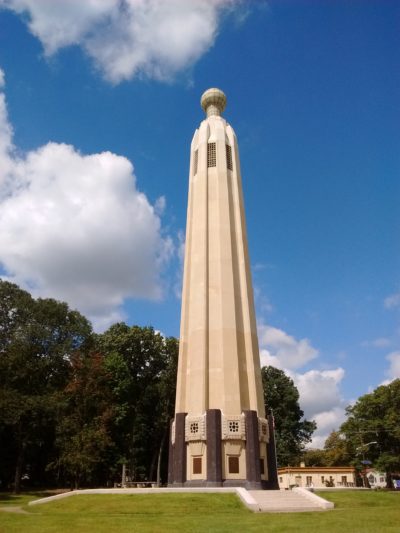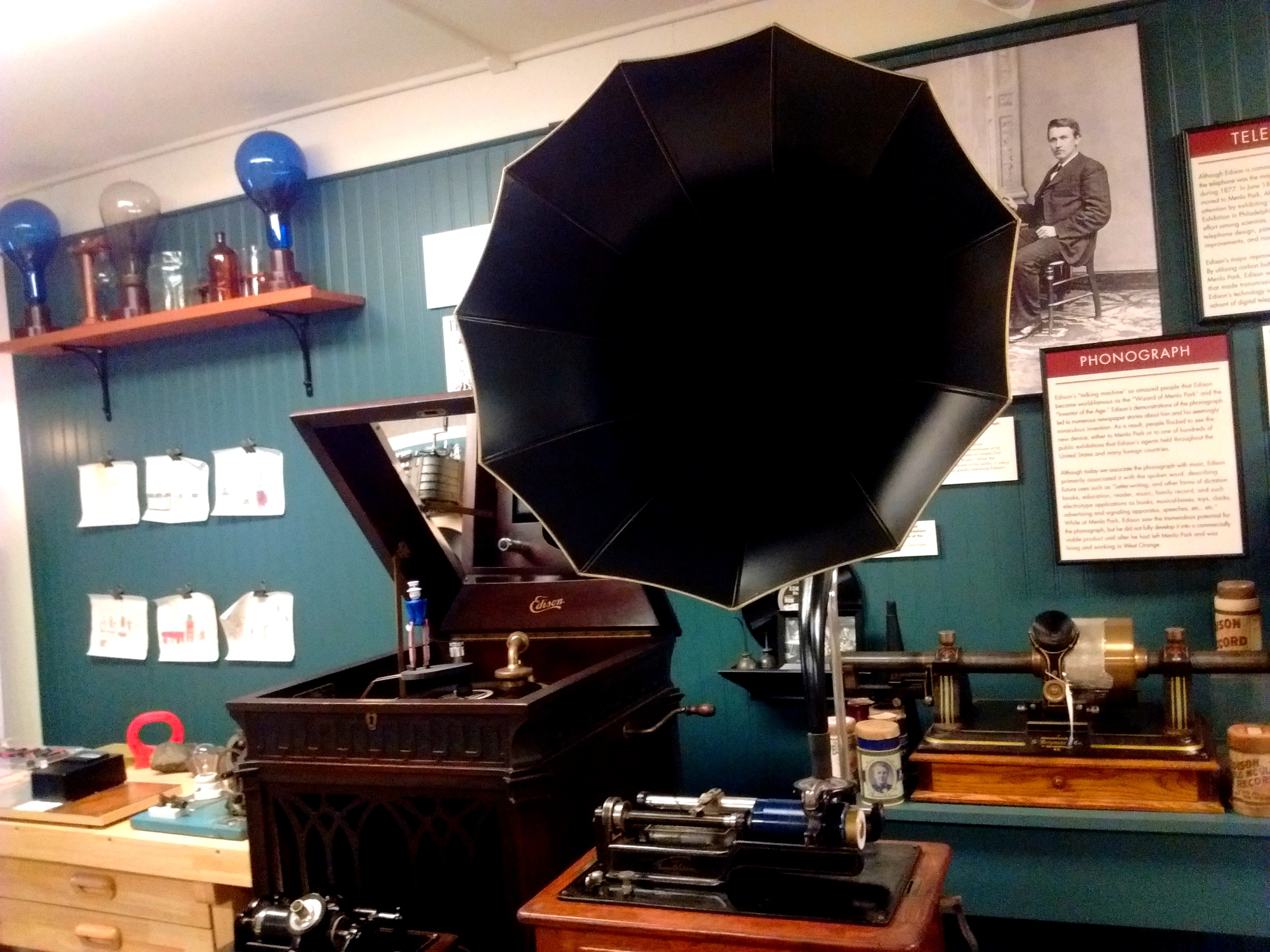I am standing inside a one-room museum on Christie Street, in what is now Edison, NJ (formerly Menlo Park), looking out at the first road in the world to be lit by electric lights. Thomas Edison lived here during a flurry of invention, production and patenting from 1876-1882. Today, the structures of the workshop and the Edison residential home, as well as those first incandescent bulb lamps, are gone.
This estate was only briefly inhabited by the iconic genius, but boasts the sites of some of his most famous discoveries. Come here to visit the spot where a bamboo filament made the first incandescent bulb shine and the desk where Edison tinkered with Alexander Graham Bell’s telephone enough for it to work better, more consistently.
This is a museum dedicated to those six early yet heady years in the career of Thomas Edison, with a heavy emphasis on his start as a child impresario. Visitors may examine the dense chemistry and philosophy books a home-schooled Tom Edison learned to read from. We are told a charming story of 12-year-old Tom saving another child by pushing him off some railroad tracks just before a train arrived. To show his gratitude, the boy’s father offered young Edison money but Tom wanted something else. The rescued boy’s father worked for Western Union, and Edison asked for telegraphy lessons and a job as his reward.
It only took a few years of employment at Western Union for Edison to pitch his first invention: a mechanical voting machine. Apparently this device made casting a ballot too easy and politicians hated to lose out on the chance to sway votes. No further investment or profit was made on this venture so Edison resolved: Never create what will not sell.

Are we impressed by a person who has that revelation as a young teenager? Are we intimidated, appalled, awed?
The energetic, passionate docents at this museum are acutely aware of the public disdain for Thomas Edison. The guides and all museum plaques try to account for the inventor’s harsh edges. His work ethic is explored in detail, describing 14+ hour days on the floor of the shop making incandescent bulbs as (a) a quirk of his genius (b) the dedication of a businessman that ushered him toward success and (c) a sign of his times, as “unions didn’t exist” (according to one guide).
That last bit is untrue. On May 19, 1886, the workers at Thomas Edison Machine Works in New York City went on strike. In response, Edison closed that workshop then relocated it to upstate New York. Unions did exist at this time and when Edison Works employees tried to unionize, Edison shut a factory down.
That leaves us to understand Edison’s work ethic as quirky, dedicated, and antagonistic to unions. It’s not a comfortable portrait.
Still, at the conclusion of my tour, one guide stepped in to say she knows it is now fashionable to rake Edison over the coals, though she couldn’t understand why. (I blame Drunk History.) She waxed editorial: Edison was a man, like any other, with good parts and bad. He had to protect his patents, she maintained, because they were his livelihood and he had a family to support. She prompted us to try to imagine life without recorded sound or electric lighting, Edison’s biggest contributions. Hard to imagine that quiet, dark world, isn’t it?
I maintain that all of that is true, but I can also consider some of the things absent from the tour. What about Edison’s contributions to the design of the electric chair, even though he disdained capital punishment? He did it to sabotage Alternating Current, which was competing with his Direct Current generators. He wrote and distributed widely his suggestion that only the unsafe, too-powerful and often lethal force of AC would be appropriate for execution of prisoners. This was a calculated move, and it worked at the time.
I cannot image a world without lightbulbs or audio files, but I also cannot imagine loving my life’s work enough to sabotage my competitors.
And then one name springs to mind: Telsa.
Today we view Nikola Tesla as a poet’s genius, a tragic figure to guide us through whatever post-post-modern malaise we live in now. He was neurotic, ill, delicate of body but fierce in mind, all-too-trusting of Edison and ahead of his time in his reinvention of the motor and vision for Alternating Current. For goodness sake, if he emigrated from Eastern Europe today he’d be living in Brooklyn (I’d wager Crown Heights) with four roommates, waiting tables between scribbling Alternating Current diagrams on napkins*.
Tesla was an immigrant, an outcast, and socially inept while Edison was the media conglomerate CEO (or Steve Jobs) we are all intrigued by but can’t quite bend our consciences to defend. In this scenario, what’s more appealing than counting yourself among Team Tesla?
In the end, Edison did what a late-19th Century entrepreneur was supposed to do, and he did it exceedingly well. He avoided unions, ruthlessly defended his patents, attacked his competitors and spread calumny about his enemies. All of that led him to victory, renown and wealth.

If we hate him for it in 2017, it’s because we are wonderstruck by his vision and persistence. We are nostalgic for him, though he is problematic. Maybe we’re nostalgic for the time before we knew he was problematic, realizing we can never be that bright-eyed third grader on a field trip looking up at incandescent bulbs again (if you grew up in what was once Menlo Park, as I did).
I don’t know that I can draw any lessons from the life and work of Thomas Edison, or make him a personal idol. I love things deeply and tinker with ideas tirelessly, but I will never be ambitious or single-minded enough to mow down anyone standing in my way. I know that’s not the way to glory, to have an Eternal Light burning for me a century after my death. Very few people achieve immortality without blood on their hands. I won’t be among the bloodied.
Work ethic isn’t my problem but office politics sure are. Squashing underdogs is distasteful to me. I don’t have the stomach for it, and if that condemns me to a life of waiting tables next to 21st Century Nikola Tesla, so be it.
* “… Tesla was prey to strange habits and phobias. He (silently) counted each step he took as he made his early morning walk down to the Ivry factory. Each activity ideally had to be divisible by three. Before eating or drinking anything, he felt obliged to calculate its cubic contents. He deeply disliked shaking hands with anyone. The mere sight of a peach brought on a fever.” (From Empires of Light: Edison, Tesla, Westinghouse and the Race to Electrify the World by Jill Jonnes.)

Laura Eppinger graduated from Marquette University in Milwaukee, Wisconsin, USA in 2008 with a degree in Journalism, and she’s been writing creatively ever since. She the blog editor here at Newfound Journal.


0 comments on “Meet the Wizard: Thomas Edison’s Long Shadow in Menlo Park, NJ”